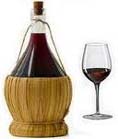Meringues
from Italian Traditional Food
What are Meringues?
Check out these great Italian ideas at Amazon for Italian food and kitchen ideas.
Meringues, a mixture of egg white and sugar, are thought to have been invented
in the early 18th century by Gasparini, a Swiss pastrycook, in the town of Mehrinyghen - hence "meringue". There
are three distinct types of meringue used for various sweet course dishes, gateaux and patisseries: suisse, cuite
and italienne.
Meringue suisse
Meringue suisse is the one most frequently made meringues. The proportion of
sugar to egg white never varies, being 2 oz caster sugar to each egg white, which is stiffly whipped before the
sugar is folded in. The number of egg whites varies according to the recipe.
This meringue is used in sweets such as vacherin (large rounds of meringue filled with whipped
cream, fruit, chestnuts etc.), or as a topping for pies such as lemon meringue pie.
The most simple way to use this type is with meringue shells which are then filled with whipped
cream.
Meringue cuite (cooked)
Meringue cuite (cooked) is a slight misnomer as it is not actually cooked in the making. It is
firmer than meringue suisse and used mainly for meringue baskets and patisserie.
Proportions are 2 oz icing sugar to each egg white (you can be generous with the weight of
sugar), and it can be made in large quantities with an electric whisk (but not over heat). If whisking by hand, it
is quicker to put the bowl of egg whites over a pan of hot water, as the heat quickens up the thickening
process.
Small meringue baskets are perhaps the nicest form of meringue to eat, as well as being an
attractive way of serving a small amount of choice fruit with cream. They are best cooked in a hotter oven than is
often advised and not for too long. In this way the meringue basket is crisp on the outside and rather
marshmallow-like inside.
Meringue italienne
Meringue italienne is really more for professionals and those engaged in patisserie work. It is
similar to meringue cuite but a lighter and finer mixture. It takes some skill to make as the lump sugar is made
into a syrup and boiled to a certain degree before being poured on to the egg whites. It is essential to use a
sugar thermometer for this meringue.
There are certain sweets which use variations of meringue suisse and meringue cuite. These
contain a small proportion of cream of tartar, resulting in a soft and somewhat sticky consistency. Hazelnut
meringue cake and a Pavlova are examples of this type.
Making meringues
Though the sugar for meringues can be measured by the tablespoon it is
wiser to use scales as accuracy ensures a uniform result.
For meringue shells or a vacherin-type sweet, a special copper bowl and a balloon whisk is best,
but not essential. The shape of the bowl and slightly-rounded whisk make for greater bulk of egg whites.
There is also less risk of overbeating which so often happens when an electric mixer or rotary
whisk is employed. If you don't have a copper bowl, whisk egg whites to a froth only with a rotary whisk or mixer,
then whisk by hand with a balloon whisk until a firm snow.
For meringue cuite and meringue italienne use a rotary whisk in a pudding basin, rather than a
mixing bowl (which is larger and more suitable for mixing or beating), or use an electric mixer.
Read more Italian traditional food related articles here

Copyright © 2009 - . All Rights Reserved
Worldwide. Italian Traditional Food
You may not reprint articles from this website
without the written permission of the site owner.
Disclaimer: Articles on this
Website are provided for information purposes only. Italiantraditionalfood.com does not accept any responsibility
or liability for the use or misuse of the article content on this site or reliance by any person on the site's
contents.
| 


 Digg
Digg Stumbleupon
Stumbleupon Google Bookmarks
Google Bookmarks Delicious
Delicious Twitter
Twitter Facebook
Facebook Yahoo My Web
Yahoo My Web Reddit
Reddit